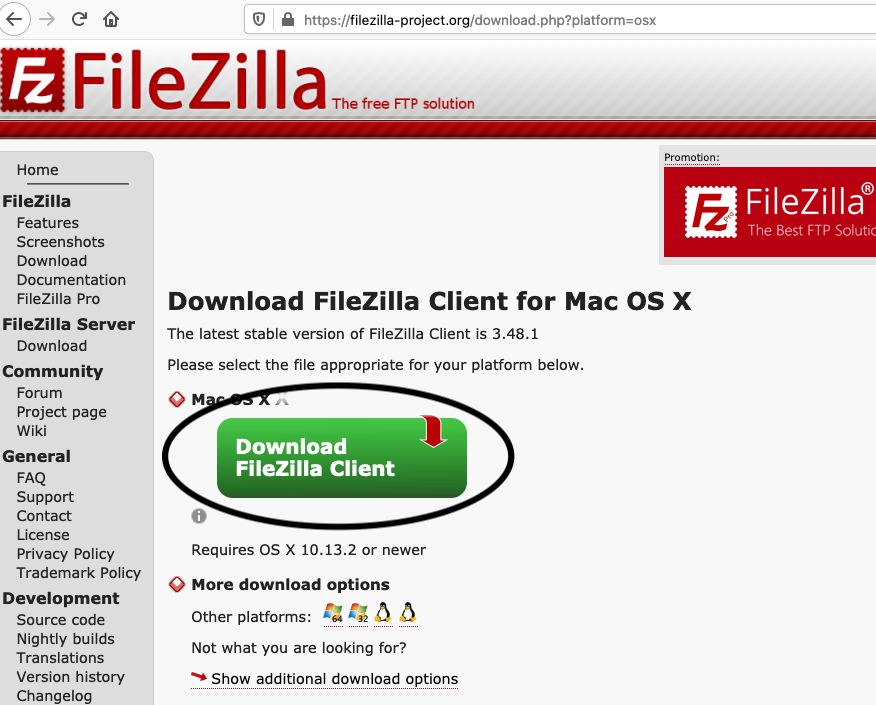

- #Unable to install filezilla mac how to#
- #Unable to install filezilla mac for mac#
- #Unable to install filezilla mac download#
- #Unable to install filezilla mac mac#
"Receiver Helper will damage your computer" virus homes in on the user-defined preferences in Safari, Google Chrome, or Mozilla Firefox. Having made it into the Mac, the e-pest shows its true colors by turning the user’s Internet defaults upside down. It tiptoes into a system as part of a multi-pronged installer that misleadingly appears to promote a harmless app with no strings attached. All of these unwelcome after-effects of the attack hold true for Receiver Helper (aka ActivityInputd, CleanParameterd, DominantPartitiond, ElementaryTyped, ManagerAnalogd, ProtocolStatus, StandardBoostd, OperativeMachined, etc.), an adware strain that’s currently seeing a sizable spike in distribution. Browser redirects that lead to shady or worthless services add a few extra touches to the nasty big picture.
#Unable to install filezilla mac mac#
Often referred to as potentially unwanted applications (PUAs), they hit the web browsing side of the Mac by incessantly displaying ads and spoofed pop-up alerts. Whereas some digital threats, such as info-stealers, are covert by design and cause harm without telltale signs of infection, the above-mentioned culprits manifest themselves more than conspicuously. Hassle-free computing is a misnomer if adware infiltrates a Mac. You should move it to the Trash" virus from Mac to remedy the affected web browser and stop obnoxious pop-ups saying that this application will damage your computer. Remove "Receiver Helper will damage your computer. Use automatic tool to uninstall “… will damage your computer” virus from your Mac.Get rid of “… will damage your computer” virus in web browser on Mac.
#Unable to install filezilla mac for mac#

#Unable to install filezilla mac download#
Step 1 – Install FileZilla Server: To install the FileZilla Server, you will need to download the FileZilla Server installer from the Filezilla site as shown below and click on Download FileZilla Server.

The administrator in charge of the firewall should always require PASV connections. However, FTP clients shouldn’t rely on the default values, as this is unsecure. If the client fails to issue a PASV command, the Data Connection defaults to port 20. In the Passive Mode, the client issues a PASV command to indicate that it will wait “passively” for the server to supply an IP and port number, after which the client will create a Data Connection to the server. In passive mode FTP, the client initiates both connections to the server, solving the problem of firewalls filtering the incoming data port connection to the client from the server. Once the FTP client receives a port, it starts the second connection and sends data. Here, the client connects and sends the PASV command, which functions as a request for a port number to connect to. Passive FTP: This is also referred to as passive mode or PASV and it was developed to resolve the issue of servers initiating the connection to the client.

In an Active Mode FTP, the client issues a PORT command to the server signaling that it will “actively” provide an IP and port number to open the Data Connection back to the client. In an active mode connection, when the client makes the initial connection and sends PORT, the server will then connect back to the client’s specified data port from its local data port, which is port 20. That is, when a client and server intend to transfer data, they usually start a control connection first in order to negotiate the details of the Data Connection prior to opening it and transferring data. In this mode, the FTP client connects from a random port (n-1023) to the FTP server’s command port (21). You may also want to see this guide: Warning: FTP over TLS is not enabled, users cannot securely log in: You appear to be behind a NAT Router, please configure the passive mode settings and forward a range of ports in your router.Īctive FTP: This was originally the only method of FTP and is therefore often the default mode for FTP.
#Unable to install filezilla mac how to#
Before proceed with the steps on how to install and connect to an FTP Server, I will like to briefly describe the difference between active and passive FTP as this is a prevalent question when dealing with Firewall configuration to support the deployment.


 0 kommentar(er)
0 kommentar(er)
